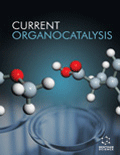- Home
- A-Z Publications
- Current Organocatalysis
- Previous Issues
- Volume 9, Issue 2, 2022
Current Organocatalysis - Volume 9, Issue 2, 2022
Volume 9, Issue 2, 2022
-
-
Liquid Membranes in Catalysis
More LessAuthors: Muhammad W. Ashraf and M. Amin MirThe supported ionic liquid (SIL) membranes have demonstrated huge potential for numerous applications in current separation science and catalysis. Membrane technology allows for the separation of complex mixtures of gases, vapors, liquids and /or solids below trivial conditions. Simultaneous chemical transformations can also be achieved in membranes by using catalytically active materials comprising the mem Read More
-
-
-
Synthesis of 1,8-Dioxo-octahydro-xanthene and Tetrahydrobenzo[b]pyran Derivatives Promoted by two Bis-imidazolium-based Ionic Liquids
More LessAuthors: Maryam Shirzad, Mitra Nasiri, Nader Daneshvar, Farhad Shirini and Hassan TajikAim and Objective: In this work, we have prepared two bis-dicationic ionic liquids with the same cationic core (Bis-imidazole) and different counter-anions using sulfuric acid and perchloric acids. After that, the efficiency and ability of these compounds as catalysts were investigated and compared with respect to the promotion of Knoevenagel condensation and synthesis of benzo[ b] pyran derivatives to see the effect of t Read More
-
-
-
Microwave-assisted, [Bmim]HSO4-catalyzed the Friedländer Quinoline Synthesis of Quinoline Under Solvent-free Conditions
More LessAuthors: Dau X. Duc and Vo Cong DungAn efficient and green method for the Friedländer quinoline synthesis has been described. The synthesis was performed under microwave irradiation using ionic liquid [Bmim]HSO4 as a catalyst. A diverse range of quinoline derivatives was obtained in high yields from 2-aminoaryl aldehydes and ketones under solvent-free conditions.
-
-
-
Polymer Supported Proline-Based Organocatalysts in Asymmetric Aldol Reactions: A Review
More LessAuthors: Rubina Shajahan, Rithwik Sarang and Anas SaithalaviThe use of proline-based organocatalysts has acquired significant attention in organic synthesis, especially in enantioselective synthesis. Proline and its derivatives are proven to be quite effective chiral organocatalysts for a variety of transformations, including the aldol reaction, which is considered as one of the important C-C bond forming reactions in organic synthesis. The use of chiral organocatalysts has several adva Read More
-
-
-
Acceleration of Baylis-Hillman Reaction using Ionic Liquid Supported Organocatalyst
More LessBackground: Baylis-Hillman reaction requires cheap starting materials, easy reaction protocol, and possibility to create the chiral center in the reaction product has increased the synthetic efficacy of this reaction which also suffers from high catalyst loading, low reaction rate, and poor yield. Objective: The extensive use of various functional or non-functional ionic liquids (ILs) with organocatalyst acts not only as reaction mediu Read More
-
-
-
Synthesis, Characterization and Biochemical Analysis of Azo-metal complex of Embelin with Second Group Transition Metals
More LessAuthors: Mohd A. Mir and Muhammad Waqar AshrafAim: The objective of the work is to synthesize, characterize and biochemically analyze Azo-metal complex of Embelin with Second Group Transition Metals. Background: The genus Embelia is a well-known herb and has considerable importance in the field of pharmaceutical chemistry. The plant species has been used considerably as a traditional medicine in Ayurveda, old Chinese medicine, and Siddha for a long time. The dried b Read More
-
-
-
The Effect of Dicarboxylic Acid Catalyst Structure on Hydrolysis of Cellulose Model Compound D-Cellobiose in Water
More LessAuthors: Harshica Fernando and Ananda S. AmarasekaraBackground: Polycarboxylic acids are of interest as simple mimics for cellulase enzyme- catalyzed depolymerization of cellulose. In this study, DFT calculations were used to investigate the effect of structure on dicarboxylic acid organo-catalyzed hydrolysis of cellulose model compound D-cellobiose to D-glucose. Methods: Binding energy of the complex formed between D-cellobiose and acid (Ebind), as well as glycosidic oxy Read More
-
-
-
One-Pot Access to 2-oxazolines via a Castro-Stephens Coupling and Intramolecular Cyclization
More LessAuthors: Dnyaneshwar Nighot, Arvind K. Jain, Imran Ali and Varun RawatAim: Here, we have reported easy one-pot access to a series of oxazolines using a modified Castro-Stephens coupling protocol. Background: 2-oxazolines have been shown to have significant biological activity and wide-ranging applications in organic chemistry. These properties make oxazolines as heterocyclic compounds of immense importance. Objective: The objective of this study is to synthesize oxazoline derivativ Read More
-
-
-
Agro-Waste Sourced Catalyst as an Eco-Friendly and Sustainable Approach for Knoevenagel Condensation Reaction
More LessBackground: The present work describes an eco-friendly and sustainable approach for the Knoevenagel condensation of an aromatic aldehyde with ethyl cyanoacetate, and salicylaldehyde with Meldrum acid for the synthesis of ethyl benzylidenecyanoacetate and 3-carboxy coumarin (2-oxo-2H-1-benzopyran) derivatives, respectively. The reaction was performed under green catalytic media-Water Extract of Watermelon Fruit Pe Read More
-
-
-
A Novel Baker’s Yeast-Mediated Microwave-Induced Reduction of Racemic 3-Keto-2-Azetidinones: Facile Entry to Optically Active Hydroxy β-Lactam Derivatives
More LessAuthors: Aparna Das, Ram N. Yadav and Bimal Krishna BanikObjective: Microwave technology, together with enzymatic catalysis, is a nature-friendly chemical synthesis method with low wastage of solvent and a good yield of the products. Methods: Enzymes from various microorganisms can be used in the biochemical processes of a wide range of compounds assisted by microwave irradiation. Results: In this work, the microwave-induced reaction of α-keto β-lactams by Baker's yeas Read More
-
Most Read This Month
Article
content/journals/cocat
Journal
10
5
false
en

Most Cited Most Cited RSS feed
-
-
Liquid Membranes in Catalysis
Authors: Muhammad W. Ashraf and M. Amin Mir
-
- More Less

